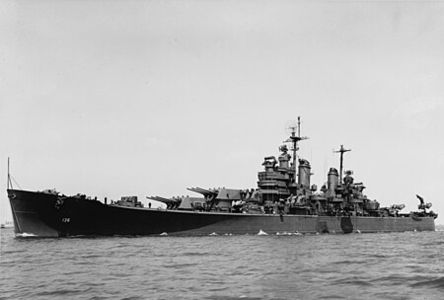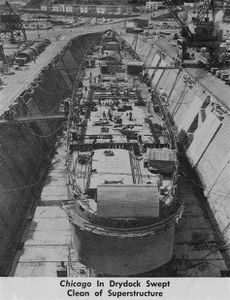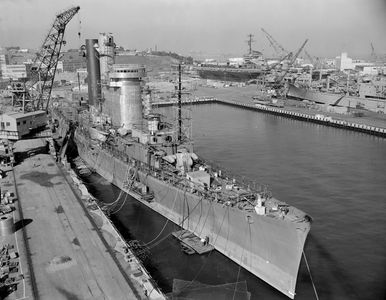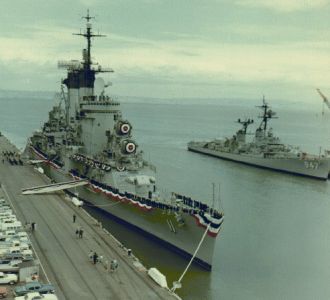USS Chicago
and should NOT be used for any reason other than reading enjoyment |
USS Chicago (CA-136/CG-11) was a Baltimore-class heavy cruiser laid down on 28 July 1943 at Philadelphia, Pennsylvania, US, by the Philadelphia Navy Yard. Launched on 20 August 1944, she was sponsored by Mrs. Edward J. Kelly, wife of the Mayor of Chicago, Illinois, and commissioned at the Philadelphia Navy Yard on 10 January 1945, Captain Richard R. Hartung, USN, in command. It served in some of the last battles around the Japan home islands in WWII, and as part of the post war occupation fleet. Decommissioned after the war it was refitted as a missile cruiser beginning in the late 1950s and recommissioned in 1964, serving during the Vietnam War. It served until 1980. USS Chicago CG-11 carried the title of "The World's Most Powerful Guided Missile Cruiser".
- The building of USS Chicago
Recommissioned as guided missile cruiser
On 1 November 1958 Chicago was reclassified CG-11 and towed to San Francisco Naval Shipyard to begin a five-year conversion to a guided missile cruiser. Begun on 1 July 1959, the entire superstructure was removed and replaced with new aluminum compartments, modernized electronic systems, and an improved Naval Tactical Data System (NTDS) equipped combat information center. Representative of the new technological focus on guided missiles, Chicago was refitted with Tartar and Talos SAM stowage, loading, launching, and guidance systems. Triple torpedo tubes, two ASROC launchers, two 5 inch/38 guns, and two antisubmarine helicopters rounded out the cruisers' modifications.
- USS Chicago weaponry
2 x TARTAR missiles [Note 1]
2 x TALOS missles[Note 2]
1 x ASROC 8 tube launcher[Note 3]
2 x 5x38 gun [Note 4]
2 x Mk-32 triple torpedo tubes amidships[Note 5]
Designed to provide long-range air, surface, and sub-surface defense for task forces, Chicago was recommissioned at the San Francisco Naval Shipyard on 2 May, 1964 and was assigned to Cruiser-Destroyer Flotilla Nine, Pacific Fleet. Preliminary acceptance trials were conducted throughout the summer until 2 September, 1962 when Chicago (with a crew of 1,142 officers and enlisted men)officially joined the First Fleet as an active unit. Following sonar calibration and deperming in Puget Sound the cruiser arrived at her home port of San Diego to begin weapons systems qualifications. Examination and evaluation of the new missile systems were completed by 2 December, following successful trials at the Pacific Missile Range off southern California.
On 4 January 1965 the cruiser shifted to Long Beach to begin a series of shock tests off San Clemente Island. Equipment tests, as well as damage control exercises, were completed by mid-January. Chicago then departed the area for San Francisco for alterations, receiving upgraded Tartar missile systems and improved electronics. The warship returned to San Diego on 17 April.
For the next two months Chicago continued shakedown training, engineering, navigation, and seamanship drills as well as missile and electronic exercises. In mid-June the cruiser began Talos fire control developmental testing with the Naval Electronics Laboratory. This, and later tests, examined guidance improvements and experimented with missile replenishment at sea.
During fleet exercise "Hot Stove" in August-September, Chicago practiced anti-air and ASW operations, including firing ASROC and tube-launched torpedoes against submerged "enemy" submarines. Following an ECM exercise, Chicago participated in a competitive missile firing exercise and won a gold Missilery "E" for her Tartar battery. During the first week of October the warship participated in another anti-air exercise, this time shooting down two high-speed, high-altitude drones with Talos and Tartar missiles.
After a cruise to Hawaii from 19 October to 3 November, during which the cruiser practiced tactical data sharing training with Kitty Hawk (CVA-63) and Mahan (DLG-11), the ship finished out the year conducting tests and exercises in the San Diego area. Local operations continued in the spring, including more missile evaluation tests through February 1966. Returning to San Diego on 4 March the ship underwent operational readiness, technical proficiency, boiler, electronics, and nuclear warfare acceptance inspections. In April, the warship participated in Exercise "Gray Ghost," where the cruiser operated as tactical flagship for the anti-air warfare commander, Rear Admiral Elmo R. Zumwalt, Jr.
1st Vietnam deployment
On 12 May 1966, Chicago set out for her first deployment in Vietnam. After stopping at Pearl Harbor and Yokosuka, where a new radar antenna was installed, the ship arrived at U.S. Naval Base Subic Bay on 12 June. Picking up her helicopter detachment, the cruiser departed the next day for duty with Task Force 77 on Yankee Station in the Tonkin Gulf.
From 15 June to 13 July, Chicago, call-sign Red Crown, began assessing the concept of radar surveillance for all U.S. Navy air operations over designated areas of the Gulf and North Vietnam. Known as PIRAZ, or "positive identification and radar advisory zone," the initial responsibilities of tracking friendly aircraft were expanded to include Air Force planes, controlling barrier combat air patrols, advising support aircraft, and coordinating strike information with the Air Force reporting center at Da Nang, South Vietnam. On 5 July, a Sikorsky SH-3 Sea King search and rescue helicopter operating from Chicago rescued an A-4E Skyhawk pilot from Constellation who had ejected off the coast of North Vietnam on 4 July. After a port visit to Hong Kong, the ship had to avoid a typhoon on 17 July.
See also [ Tiger cruise ]
Notes
- ↑ TARTAR missiles medium range SAM; weight: 1,200 lbs; length: 16ft; Solid fuel rocket engine; range: 8,6 miles, 65k feet alt; speed: mach 1,8;
- ↑ TALOS SAM; weigh 7,800 lb (missile: 3,400 lb (1,500 kg), booster: 4,400 lb (2,000 kg), 32 ft, Warhead: 465 lb continuous-rod HE warhead or W30 nuclear warhead (2–5 kt)); range: Engine Stage 1: Hercules MK 11 solid-fueled rocket booster; Stage 2: Bendix ramjet sustainer 20,053lbf, 89.20kN ; Operational range: 130 nm; ceiling 80,100 ft (16 miles); Maximum speed Mach 3
- ↑ ASROC (Anti-submarine rocket) weigh 1100 lbs, 100 lb warhead (10KT nuclear capable), 6 mile range, Chicago had 8 missiles in launchers with 24 reloads
- ↑ Deck guns fire a five inch diameter; 55 lb shell at 2,600 ft/sec, 15 rounds per minute
- ↑ Each torpedo: weight: 508 lbs; >weight: 3,200 lbs; range: 6 miles; depth :1200 ft; at 46 mph
- For a more complete history of the USS Chicago
-
- More information is available at [ Wikipedia:USS Chicago (CA-136) ]
What links here • References and Sources • Help • Contact info • Category:Root ⤴




![2 x TARTAR missiles [Note 1]](/a/images/thumb/7/71/Chicagol-Tartar.jpg/325px-Chicagol-Tartar.jpg)
![2 x TALOS missles[Note 2]](/a/images/thumb/a/a9/Chicago-Talos.jpg/450px-Chicago-Talos.jpg)
![1 x ASROC 8 tube launcher[Note 3]](/a/images/thumb/b/bd/ASROC_launcher.JPG/401px-ASROC_launcher.JPG)
![2 x 5x38 gun [Note 4]](/a/images/thumb/7/71/5-38_naval_un.jpg/451px-5-38_naval_un.jpg)
![2 x Mk-32 triple torpedo tubes amidships[Note 5]](/a/images/thumb/7/73/US_Navy_Torpedo_Test%2C_2016.jpg/450px-US_Navy_Torpedo_Test%2C_2016.jpg)